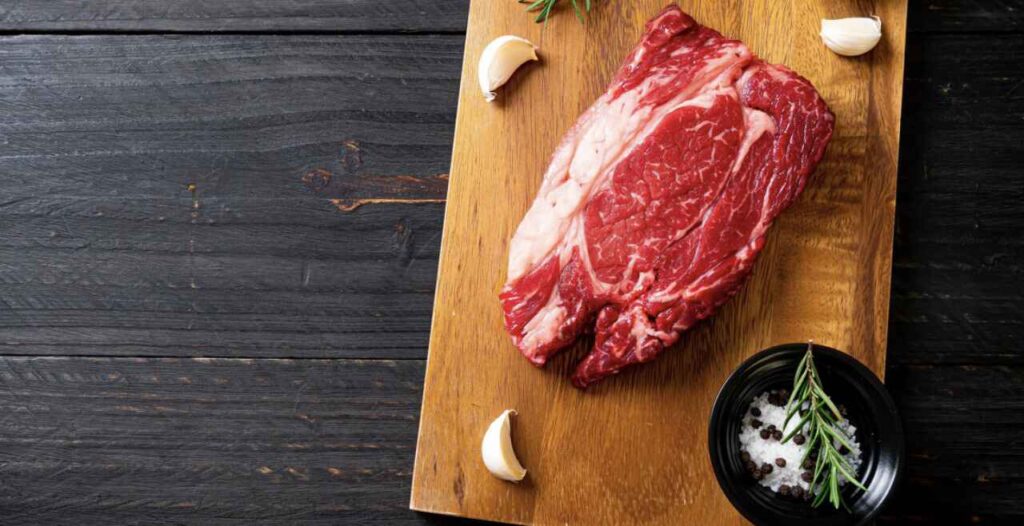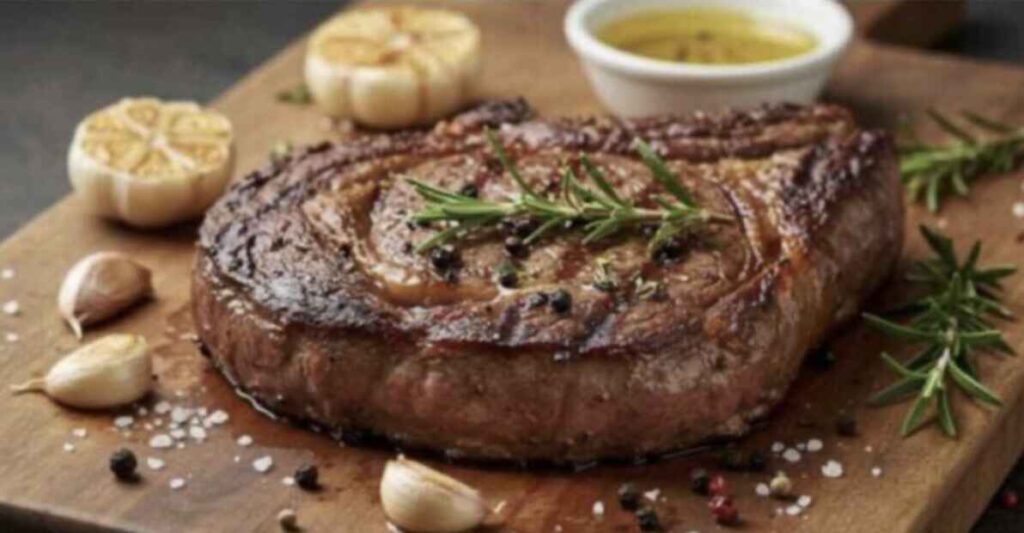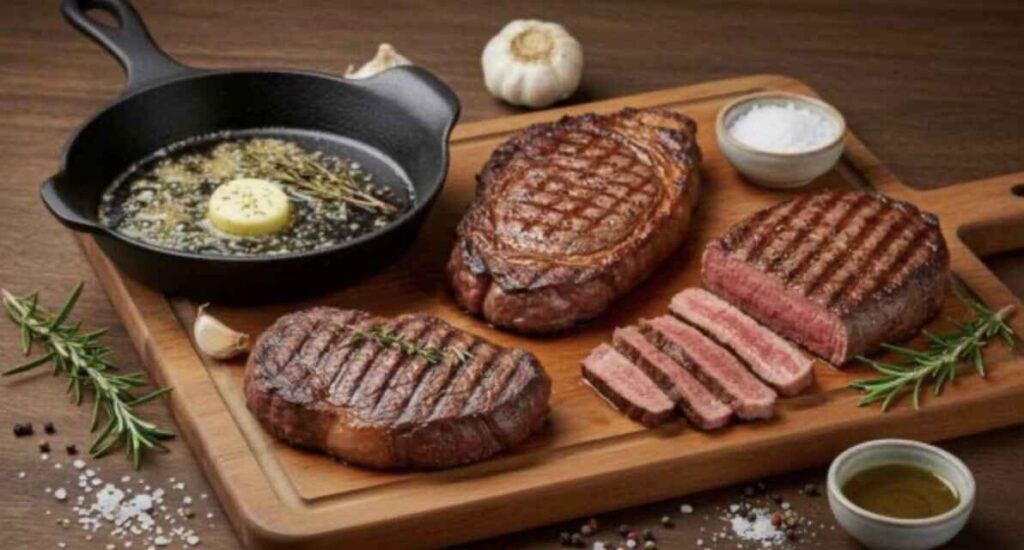What Is Beef Steak?
Beef steak is meat cut from a cow that’s cooked by heating it quickly at high temperatures. It’s usually thick, juicy, and super flavorful! Steaks come from different parts of the cow, which gives us many types like ribeye, sirloin, and filet mignon.
Table of Contents
Why People Love Steak So Much
First, people love steak because it has a rich, meaty flavor that’s hard to beat! When cooked right, steak has a crispy outside and a tender inside that practically melts in your mouth.
Also, steak is packed with protein, which helps build strong muscles. That’s why many athletes and fitness fans choose steak as their favorite meal.
Steak Around the World
Steak is popular in many countries because it’s both simple and special. In Argentina, they’re famous for their amazing grilled steaks called “asado.” In Japan, they have fancy Kobe beef steaks that come from specially raised cows.
People everywhere enjoy steak because it can be cooked in different ways to match local tastes. Some like it with spicy sauces, while others prefer just salt and pepper to let the meat’s natural flavor shine through.
That’s why, whether you’re at a fancy restaurant or a backyard barbecue, steak brings people together for a delicious meal that’s been loved for centuries!
Classic Beef Steak Recipe
Ingredients You’ll Need

- Beef steak (ribeye, sirloin, or strip steak) – The star of the show! Choose a cut that’s at least 1-inch thick with good marbling (those little streaks of fat) for the best flavor and tenderness.
- Kosher salt – Salt enhances the natural flavor of the beef and helps create a delicious crust when cooking. It also draws moisture to the surface, which helps with browning.
- Freshly ground black pepper – Adds a touch of spice and complexity that complements the rich beef flavor perfectly.
- High-heat cooking oil (like avocado, grapeseed, or canola oil) – Oil prevents the steak from sticking to the pan and helps transfer heat evenly for that beautiful brown crust.
- Unsalted butter – Added near the end of cooking, butter creates a nutty, rich flavor as it browns and bathes the steak. It’s what gives restaurant steaks that special something!
- Fresh garlic cloves – These add a subtle, aromatic flavor that infuses into the steak when added to the butter.
- Fresh herbs (like rosemary, thyme, or sage) – Herbs infuse the butter with fragrant flavors that complement the beef without overpowering it.
Why These Ingredients Matter
The combination of salt and pepper is classic because they enhance rather than mask the natural flavors of good beef. Next, using the right oil ensures your steak can cook at high temperatures without burning.
Then, the butter, garlic, and herbs create what chefs call an “aromatic baste.” After that, when you spoon this flavored butter over the cooking steak, it adds layers of flavor while keeping the meat moist and tender.
This simple ingredient list is the foundation of steakhouse-quality cooking. The magic happens in how you use these basic ingredients to bring out the best in your beef!
How To Cook The Perfect Beef Steak
Preparation Steps
Getting Your Steak Ready
- Take your steak out of the refrigerator 30-45 minutes before cooking. Room temperature meat cooks more evenly.
- Pat the steak dry with paper towels. This helps create a better crust.
- Season generously with salt and pepper on both sides. Press the seasonings gently into the meat.
- Let the seasoned steak rest while you prepare your cooking surface.

Cooking Process
Searing Your Steak
- Heat a heavy skillet or cast-iron pan over high heat until very hot. The pan should be smoking slightly.
- Add a tablespoon of high-heat oil to the pan and swirl to coat.
- Carefully place your steak in the hot pan. It should sizzle immediately.
- Let it cook without moving it for 3-4 minutes for a good crust to form.
- After the first side is browned, flip the steak using tongs, not a fork (to keep juices inside).
Finishing Your Steak
- Cook the second side for about 3 minutes for medium-rare. Add an extra minute for medium, or two for well-done.
- When the steak is almost done, add butter, garlic cloves, and herbs to the pan.
- Tilt the pan slightly and use a spoon to baste the steak with the melted butter mixture for about 1 minute.
- Now check for doneness. For medium-rare, the steak should feel like the fleshy part of your thumb when you touch your thumb and index finger together.
- Remove the steak from the pan and place it on a cutting board or plate.
- Let the steak rest for 5-10 minutes. This allows juices to redistribute throughout the meat.
- Finally, slice against the grain and serve immediately.
Helpful Tips
- For a 1-inch thick steak, typical cooking times are: 4-5 minutes total for rare, 6-7 minutes for medium-rare, 8-9 minutes for medium, and 10-12 minutes for well-done.
- When you flip the steak, put it in a different spot on the pan where it’s still hot.
- The butter might smoke a little – that’s normal and adds flavor.
- Let your steak rest after cooking or all the juices will run out when you cut it.
- A meat thermometer is your best friend: 125°F for rare, 135°F for medium-rare, 145°F for medium, 155°F for medium-well.
Delicious Ways to Serve Beef Steak
Classic Side Dishes
Potato Options
Potatoes are perfect partners for steak. For example, crispy french fries offer a wonderful contrast to juicy steak. Also, creamy mashed potatoes soak up the meat juices deliciously. Baked potatoes with butter and sour cream are simple but satisfying too.
Vegetable Sides
Fresh vegetables balance the richness of steak. Grilled asparagus is quick to prepare and looks elegant on the plate. Also, sautéed mushrooms complement the meaty flavor wonderfully. Steamed broccoli or green beans add color and nutrition to your meal.
Grain Companions
Rice makes an easy side dish that works well with steak. Simple buttered rice lets the steak flavor shine. So does a wild rice pilaf if you want something more interesting. Dinner rolls or garlic bread are great for soaking up juices and sauces.
Tasty Sauces for Steak
Classic Steak Sauces
A good sauce can take your steak to the next level. Peppercorn sauce adds a spicy kick that many steak lovers enjoy. Also, mushroom gravy brings earthy flavors that blend perfectly with beef. Red wine sauce feels fancy but is actually quite simple to make.
Simple Options
Not every sauce needs to be complicated. For example, herb butter melting over a hot steak creates an instant sauce. Also, steak sauce from a bottle is perfectly fine for everyday meals. Even ketchup works well, especially with more casual steak dinners.
Easy Meal Combinations
Family Favorites
Steak and baked potato is a classic combination that everyone loves. Also, steak with mac and cheese pleases both adults and kids. Steak salad is perfect when you want something lighter but still satisfying.
Quick Weeknight Ideas
Sliced steak over rice with your favorite sauce makes dinner quick and easy. Also, steak sandwiches with melted cheese turn leftover steak into a new meal. So, don’t be afraid to keep things simple – good steak doesn’t need much fuss to be delicious!
Different Ways to Cook Beef Steak
Cooking Methods

Grilling gives steak a delicious smoky flavor and beautiful char marks. This way, the high heat creates a nice crust while keeping the inside juicy. For best results, preheat your grill to very hot before adding the steak.
Pan-searing is perfect when you don’t have access to a grill. A cast-iron skillet works best because it holds heat really well. You could also finish your steak in the oven after searing for more even cooking.
Broiling is another idea that mimics grilling but uses your oven’s top heating element. Place the steak on a broiler pan close to the heat source and watch it carefully to prevent burning.
Sous vide cooking involves sealing the steak in a plastic bag and cooking it in temperature-controlled water. This way, you get perfectly even doneness before finishing with a quick sear for texture.
Seasoning Variations
Salt and pepper are classics, but you could also try a dry rub with paprika, garlic powder, and brown sugar for a slightly sweet and smoky profile.
Another idea is using herbs like rosemary, thyme, and crushed garlic cloves. These aromatics can be added to the pan while cooking to infuse flavor into the meat.
Marinades work wonderfully for tougher cuts. A simple mix of olive oil, soy sauce, and balsamic vinegar tenderizes the meat while adding depth of flavor.
Coffee grounds make a surprisingly delicious steak crust. The coffee brings out the beef’s natural flavors and creates an amazing aroma.
International Flavors
Try a Mexican-inspired steak with cumin, chili powder, and lime juice. This way, you can serve it with warm tortillas for quick fajitas.
You could also make an Asian-style steak with ginger, soy sauce, and a touch of honey. The sweet and savory combination works beautifully with beef.
Another idea is Argentine chimichurri sauce, made with fresh parsley, garlic, vinegar, and oil. The bright, herbal flavor contrasts perfectly with rich steak.
French-style steak au poivre features a crust of cracked peppercorns and a creamy cognac sauce. This transforms a simple steak into an elegant dinner.
Finishing Touches
Compound butter melting over a hot steak adds richness and flavor. Mix soft butter with blue cheese or herbs for an instant sauce.
You could also try a quick pan sauce made with the steak drippings, some wine, and a bit of stock. This way, no flavor goes to waste.
Slicing your steak thinly against the grain is another idea that changes the eating experience, making even tougher cuts more tender and enjoyable.
Give Beef Steak a Try!
In conclusion, cooking beef steak at home is much easier than many people think! With just a few basic ingredients and some simple techniques, you can create a restaurant-quality meal right in your own kitchen.
So don’t be intimidated by cooking steak—it’s actually one of the quickest meals you can make. Even beginners can master the basics of cooking a delicious steak with a little practice. That’s why it’s perfect for both special occasions and weeknight dinners when you want something satisfying without spending hours in the kitchen.
Remember that cooking steak is partly science but also an art. Each time you prepare it, you’ll learn something new about your preferences—whether you like it rare or well-done, with simple seasoning or bold flavors. The more you practice, the better your steaks will become!
I’d love to hear about your experience trying these steak recipes and techniques. What’s your favorite way to cook and serve steak? Do you have any special tricks or family recipes that make your steak stand out? Share your successes and even your learning experiences—they’re all part of becoming a better cook!
That’s why I encourage you to experiment and make these recipes your own. Cooking should be fun and rewarding, and few dishes offer the immediate satisfaction of a perfectly cooked steak!

